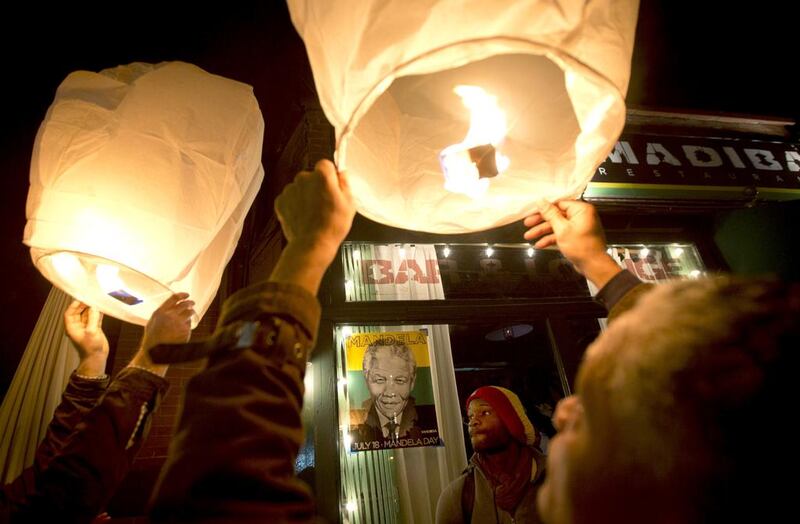NEW YORK // Months after Nelson Mandela was released from prison, 750,000 New Yorkers lined the streets in June 1990 to catch a glimpse of South Africa’s anti-apartheid hero, or flocked to City Hall to hear him speak during his first stop on a landmark tour of the United States.
Fifty thousand alone thronged Kennedy airport, where his motorcade through the city began, culminating in a ticker-tape parade down Broadway, attended by 400,000. But it was perhaps in the majority black neighbourhoods of central Brooklyn where the joy was most visceral.
Cheering residents lined the streets, holding anti-apartheid banners and raising clenched fists as Mandela slowly made his way to the historically black Boys and Girls High School, the first stop on his tour.
People chanted “Mandela! Mandela” as he addressed the adulatory crowd of about 3,000. “We in South Africa have always known that we have loyal friends among the people of New York, but we have no idea that we were perceived with such love and warmth,” Mandela said from a makeshift stage, according to a report of the event in the New York Times.
After news of his death on Thursday, makeshift memorials were set up in historically African-American neighbourhoods across the city, and the flags at city hall flew at half staff. The mayor announced that a new high school, the Nelson Mandela School for Social Justice, would be housed at Boys and Girls.
Stan Kinard, 45, a teacher at the school then and now an administrator, said seeing Mandela in person was surreal and “produced a real sense of pride that we were living this historical moment that was taking place right before our very eyes”.
“It was probably greater than Obama being elected president,” he said. “It was the first time we’d laid eyes on him, because there weren’t a lot of pictures of him during his incarceration.”
For Mr Kinard, like many Americans who came of age in the 1970s and 80s, the anti-apartheid movement had been the defining political issue of his college years. “To have spent so many years fighting for the liberation of South Africa, some of us were just shocked that he got out of prison; we were in awe.”
As Mandela’s motorcade pulled away, hundreds of teenagers ran alongside the cars, cheering him on.
At all of the eight cities Mandela visited on his 11-day tour of the US, African Americans turned out in huge numbers to see him. The trip was intended to pressure Congress and the administration of president George H W Bush to keep sanctions on the South African government while Mandela’s ANC party negotiated a political transition, and to raise funds for the party.
But the tour came at a time of increasing racial tensions in the US, and growing anger among African Americans that the promises of the civil-rights movement of the 1960s were still unfulfilled. Mandela’s presence in the country inspired many blacks in a way their own leaders could not.
“There was a symbiotic relationship between the civil-rights movement in the US and the anti-apartheid movement, they fed off of each other during the 1980s and so there was a lot of enthusiasm here,” said Princeton Lyman, who was the US ambassador to South Africa during the run-up to the historic 1994 elections that brought Mandela to power.
During the Cold War, white minority-ruled South Africa was a close ally of the West, and Margaret Thatcher and Ronald Reagan both called Mandela and the ANC terrorists. Reagan even vetoed sanctions against the regime that passed Congress.
Though the Cold War had ended, Mr Bush and his fellow Republicans were still sceptical of Mandela, and had signalled their desire to lift sanctions after Mandela’s release.
The outpouring of international support allowed Mandela to stick to his principles, including his support for Palestinians. Before his address to Congress, Mandela sat for a town-hall style interview with ABC’s Ted Koppel and took pointed questions from prominent Jewish-American leaders, who said his support for the PLO was amoral and “hypocritical”.
Mandela told Koppel that Yasser Arafat was a “comrade in arms” because he had supported the ANC when the US and other Western countries had not.
Though he lost some support, Mandela’s transfixing charisma and moral standing allowed him to score an important strategic victory nonetheless, after Mr Bush relented and promised that sanctions would remain.
The US trip “strengthened his position in South Africa vis-a-vis negotiations because it demonstrated very clearly the degree of support he had, not only in the US but also in the international community”, Mr Lyman said.
The South African government’s resistance to negotiating with the ANC “melted away after his coming here and the enormous outpouring – it was very clear the ANC would be in the driver’s seat”, he said.
Anthony Marx, now the president of New York Public Library, was an academic working on a book on South Africa at the time, and had just returned from living there during emergency rule, one of the few Americans to have done so.
“Nineteen-ninety was an amazing moment where all of the dreams and possibilities seemed to come together,” Mr Marx said. “You dared not believe it would come to be and then it hits, and it’s no longer an idea of living martyrdom, he’s a human being bringing the country together rather than tearing itself apart.
“His visit to New York was the global icing on the cake. I’ve been a New Yorker my whole life and I’ve never seen anything like it,” he said. “And I’m not sure I will see anything like it again.”
tkhan@thenational.ae





